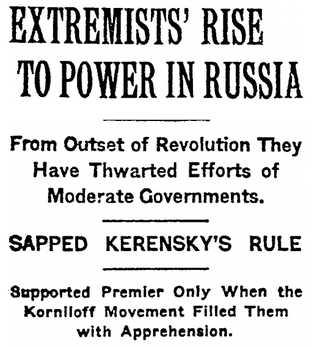
October Revolution
Second of two 1917 revolutions in Russia / From Wikipedia, the free encyclopedia
Dear Wikiwand AI, let's keep it short by simply answering these key questions:
Can you list the top facts and stats about October Revolution?
Summarize this article for a 10 year old
The October Revolution,[lower-alpha 1] also known as the Great October Socialist Revolution,[lower-alpha 2] (in Soviet historiography) or October Coup,[5] was a revolution in Russia led by the Bolshevik Party of Vladimir Lenin that was a key moment in the larger Russian Revolution of 1917–1923. It was the second revolutionary change of government in Russia in 1917. It took place through an armed insurrection in Petrograd (now Saint Petersburg) on 7 November 1917 [O.S. 25 October]. It was the precipitating event of the Russian Civil War.
| October Revolution | |||||||
|---|---|---|---|---|---|---|---|
| Part of the Russian Revolution, the Revolutions of 1917–1923 and the Russian Civil War | |||||||
 The Winter Palace of Petrograd, one day after the insurrection, 8 November | |||||||
| |||||||
| Belligerents | |||||||
|
|
| ||||||
| Commanders and leaders | |||||||
|
|
| ||||||
| Strength | |||||||
| |||||||
| Casualties and losses | |||||||
| Few wounded Red Guard soldiers[4] | All imprisoned or deserted | ||||||



The October Revolution followed and capitalized on the February Revolution earlier that year, which led to the abdication of Nicholas II and the creation of a provisional government. The provisional government, led by Alexander Kerensky, had taken power after Grand Duke Michael, the younger brother of Nicholas II, declined to take power. During this time, urban workers began to organize into councils (soviets) wherein revolutionaries criticized the provisional government and its actions. The provisional government remained unpopular, especially because it was continuing to fight in World War I, and had ruled with an iron fist throughout the summer (including killing hundreds of protesters in the July Days).
Events came to a head in the fall as the Directorate, led by the left-wing Party of Socialist-Revolutionaries (SRs), controlled the government. The far-left Bolsheviks were deeply unhappy with the government, and began spreading calls for a military uprising. On 10 October 1917 (O.S.; 23 October, N.S.), the Petrograd Soviet, led by Trotsky, voted to back a military uprising. On 24 October (O.S.; 6 November, N.S.) the government shut down numerous newspapers and closed the city of Petrograd in an attempt to forestall the revolution; minor armed skirmishes broke out. The next day a full scale uprising erupted as a fleet of Bolshevik sailors entered the harbor and tens of thousands of soldiers rose up in support of the Bolsheviks. Bolshevik Red Guards forces under the Military-Revolutionary Committee began the occupation of government buildings on 25 October (O.S.; 7 November, N.S.), 1917. The following day, the Winter Palace (the seat of the Provisional government located in Petrograd, then capital of Russia) was captured.
As the Revolution was not universally recognized, the country descended into the Russian Civil War, which would last until 1923 and ultimately lead to the creation of the Soviet Union in late 1922. The historiography of the event has varied. The victorious Soviet Union viewed it as a validation of their ideology, and the triumph of the worker over capitalism. During Soviet times, revolution day was a national holiday, marking its importance in the country's founding story. On the other hand, the Western Allies saw it as a totalitarian coup, which used the democratic Soviet councils only until they were no longer useful. The event inspired many cultural works, and ignited communist movements across Europe and globally. Many Marxist–Leninist parties around the world celebrate October Revolution Day.